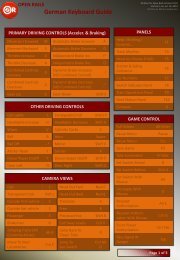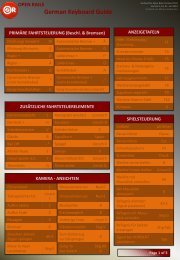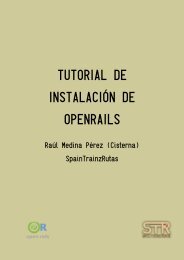Operations Manual - Open Rails
Operations Manual - Open Rails
Operations Manual - Open Rails
You also want an ePaper? Increase the reach of your titles
YUMPU automatically turns print PDFs into web optimized ePapers that Google loves.
community.<br />
Looking ahead to 2013, we still have lots of work to do.<br />
Our basic goals are unchanged - moving from Foundation to Realism and eventually to<br />
Independence. Following are just some of the highlights of what the community can expect in<br />
the upcoming months from the <strong>Open</strong> <strong>Rails</strong> team.<br />
• Totally new signaling, interlocking and AI train control modules<br />
This design allows for simulation from "dark" territory to today's high speed European systems<br />
and allows for signal and train control that spans operating eras from the Train Order &<br />
Timetable to the most sophisticated CTC systems. As part of this effort, <strong>Open</strong> <strong>Rails</strong> will offer<br />
dynamic AI where each train solves their pathing and routing more than 10 times per second.<br />
This means that each time an Activity is run, AI trains will react, in real time, to the timing of<br />
meets and other variables. The main goals achieved are:<br />
• Minimize deadlocks between player and non-player trains<br />
• Allow non-player trains to have complete pathing, movement orders (i.e. pickups, drop<br />
offs) and timetable management<br />
• Simple ability to customize signals to accommodate regional, geographic, or operational<br />
differences<br />
• Allow for dynamic pathing/signaling solutions within activities based on real time<br />
adjustments to player and non-player train location, timing and work orders<br />
• Ability to use mixed signal environments - dark territory to full automatic in-cab train<br />
control within different or the same route<br />
• Ability to pop-up a local dispatcher view of signaling and route to manually make<br />
adjustments and changes to signal states and routes through signals<br />
• Ability to prioritize trains as per prototype operations<br />
• Elimination of AI Dispatcher and its inherent logic problems to be replaced by self-aware<br />
AI trains<br />
The net impact will be the implementation of a next generation Activity Editor for setting up<br />
paths (routes through signaling and interlocking) for both Player and AI trains.<br />
• Next generation physics model for adhesion, traction, engine components and their interaction<br />
with the 3D world<br />
The physics underlying adhesion, traction, engine components and their performance will be<br />
based on a world-class simulation model that takes into account all of the major components of<br />
diesel, electric and steam engines. This includes elements never before simulated in a<br />
11






